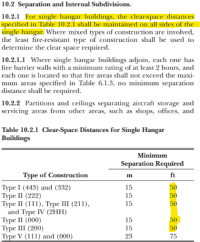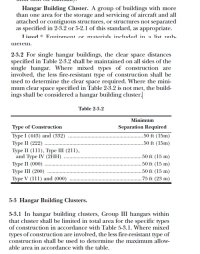I am not sure that I agree that this is the controlling code section and in reading the code commentary see below the exception you refer to only exempts from the provisions of 705.5 and 705.8 not the special requirement of chapter 4. The requirements of 412.3.1 are "SPECIAL DETAILED REQUIREMENTS" and specific to aircraft related occupancies.
Exception 1 permits two buildings on the same lot
to be exempt from Sections 705.5 and 705.8 when
considered as one building in accordance with Section
503.1.2.
Section 412.3.1 does include "Special Detailed Requirements" for hangars, but that does not mean you ignore the rest of the building code.
Section 705.3, Exception 1, is permitted since nothing in Section 412.3 prohibits its use, and Exception 1 does not exclude hangars. How are two hangars separated by 30 feet any more hazardous than two bays within the same hangar building? I would argue that two hangar bays, each in a separate building with a 30-foot distance between them, are less hazardous. If the total building area of the two buildings complies with the allowable area requirements for the most restrictive construction type and they meet all other requirements for hangars, then I see no reason why Exception 1 cannot be used.
Further, the use of "
lot lines" (italicized) in Section 412.3.1 is limited to the definition of a
lot line--not imaginary lines between buildings on the same lot. The imaginary lines permitted for Sections 705.5 and 705.8 are not
lot lines. Additionally, Section 412.3.1 does not use the term
fire separation distance, which would allow measurement to an imaginary line; it only states a specific minimum distance to
lot lines and
public ways.
This raises another interesting conundrum: At what point do you measure the distance to a
public way?
Per the definition of
fire separation distance (FSD), it is measured to the centerline; however, FSD is not used in Section 412.3.1. Thus, I would interpret this to mean the bounding edge of the
public way, which could be the
lot line at the edge of a road or street right-of-way, or the edge of an easement that qualifies as a
public way.




